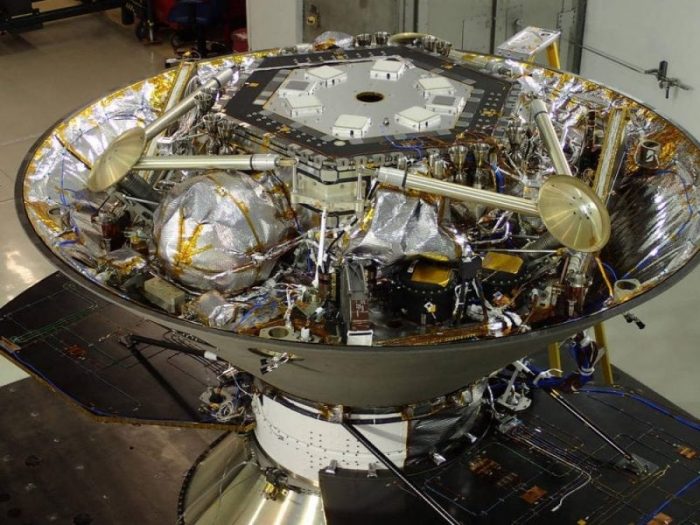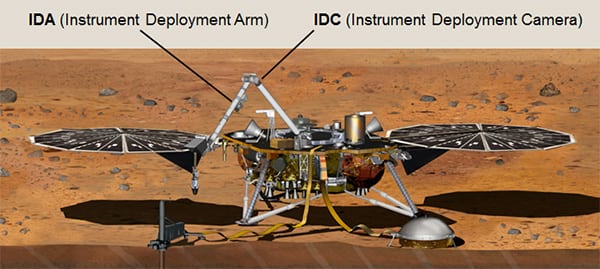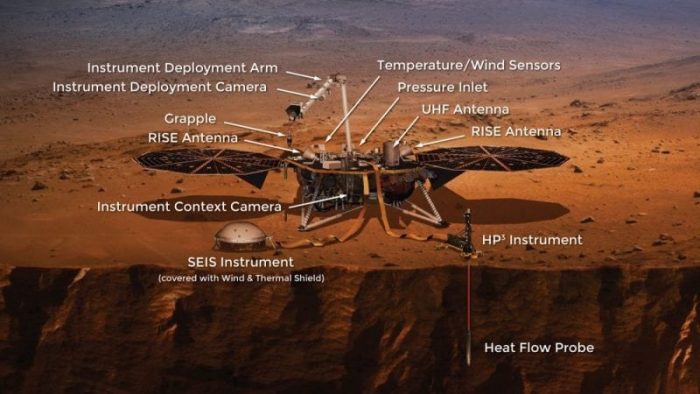
The next Mars lander, InSight, is currently preparing for its upcoming launch in May by deploying its solar panels inside Lockheed Martin’s lab in Colorado.
With InSight’s slated launch in a few months, we figured we would go over just what InSight is and what it will do for our understanding of Mars.
Studying whether there’s life on Mars or studying how the universe began, there’s something magical about pushing back the frontiers of knowledge. That’s something that is almost part of being human, and I’m certain that will continue. – Sally Ride
Meet InSight
Meet InSight (Interior Exploration using Seismic Investigations, Geodesy and Heat Transport), NASA’s most recent Mars lander slated for launch in May of 2018. This baby is quite the machine, capable of teaching us so many things about the interior of Mars and it will even help us understand how the terrestrial planets were formed (Mercury, Venus, Earth, and Mars). InSight is a stationary lander that will study Mars’ interior using a number of different instruments created by different country’s space agencies.
Insight’s Payload

The interior view of InSight. Image Source: NASA
InSight has two primary scientific payloads, SEIS and HP3, and then a few other pieces of equipment to help support the primary payload. Let’s go over what InSight has packed inside:
Heat Flow and Physical Properties Package (HP3):
- Created by German Space Agency (also called DLR)
- HP3 is a self-penetrating device that will dig (and burrow itself) down into Mar’s surface that will measure temperatures every few centimeters to measure what the temperature is in Mar’s subsurface
- This will allow scientists to figure out how much heat is escaping Mars‘ interior
Seismic Experiment for Interior Structure (SEIS)
- Created by the French Space Agency (CNES), the Swiss Federal Institute of Technology (ETH), the Institut de Physique du Globe de Paris (IPGP), the Max Planck Institute for Solar System Research (MPS), Imperial College, Institut Superieur de L’aeronautique et de I’espace (ISAE), and Jet Propulsion Lab (JPL)
- SEIS will monitor and measure the internal activities occurring inside Mars, including quakes
- This instrument will help NASA and other scientists understand a little bit more about the structure of Mars, as well as Mars’ crust and mantle
- Will also help scientists learn how Mars’ core and crust has handled meteor impacts
Other instruments in InSight
Rotation and Interior Structure Experiment (RISE)
- Created by JPL
- RISE will use radio to give the exact measurements of Mars’ rotation to actually help scientists understand the planet’s interior
- Once the measurements are determined the researchers can determine the density and size of the mantle and the core of the planet
- This instrument is what will help us better understand how the terrestrial planets formed
Instrument Deployment Arm (IDA) and Instrument Deployment Camera (IDC)

The IDA and IDC. Image source: JPL
- Created by JPL
- These 2 arms will place the different instruments on the ground for their mission
Temperature and Winds for InSight (TWINS)
- Created by Centro de Astrobiologia
- This instrument will monitor the weather for InSight’s landing site
InSight’s Important Facts

A look at InSight’s instruments. Image source: NASA
Now we will go over some crucial specifications of the InSight lander.
- Weight: 794 pounds
- Dimensions: 20 feet wide
- Powered by: InSight has 2 solar panels that will deploy after the lander actually lands on the Martian surface
InSight’s Launch and Landing
InSight was actually postponed in 2016 after the SEIS was found to have vacuum issues. It was originally supposed to launch in March of 2016 and NASA announced that the new time frame would be May of 2018. As of right now (January of 2018) it is still on schedule to be launched between May 5 and June 8. InSight will launch out of Vandenberg Air Force Base near Lompoc, California. This will actually be the first time that an interplanetary mission that will launch from California.
The landing site needed to be near the equator of Mars so the solar arrays could be powered up, but because there were no distinct surface goals the landing site did not have to be specific. The surface did need to be relatively rock free so that no complications arose when the InSight landed. The area that was chosen Is Elysium Planitia because it met all the needs that InSight had. After the general area was chosen then NASA was able to use the Mars Reconnaissance Orbiter (MRO) to chose an exact location. In March of 2016 JPL announced the location that InSight will land it.
InSight will land in the western portion of Elysium Planitia at 4.5°N 135.9°E.
After InSight lands, it will conduct its 728 days (which is roughly 708 sols) mission to learn what it can about the Martian subsurface and core.
Other Upcoming Mars’ Missions
As many of you might know, we have had quite a few missions to Mars already, have some ongoing now, and have quite a few more planned for the future. Besides InSight NASA currently has 2 future missions planned; ExoMars rover and a Mars 2020 rover.
We have slightly covered the ExoMars rover, which will launch sometime in 2020. That rover’s mission is to see if it can discover any sign for if Mars had past life at some point. It will have a multitude of different instruments that will check the surface for certain life signatures, which includes chemicals and any morphological signatures.
The Mars 2020 rover will also be looking into Mars’ past by looking at its geology to see if Mars was ever once habitable. This rover is currently not named, but expect more information to come out about it soon. The launch window is between July of 2020 and September of 2020 and will be managed by JPL, just like the InSight lander.
All these missions to Mars might seem ridiculous, but they are all very crucial in helping us understand not only Mars but the four terrestrial planets. We still have no real idea how our planets formed, and the InSight mission will help us begin to understand that.









